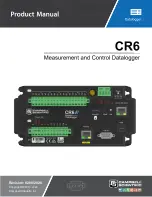
ibaBM-SLM Manual
8
ibaBM-SLM functionality on the SIMOLINK Bus
The following section provides a short, summary description of the properties and the
parameters of the SIMOLINK bus.
8.1
Bus Topology
A fiber-optic ring, operating at 11 Mbps defines the basic SIMOLINK bus topology. A
Siemens SLB (SIMOLINK Board) is integrated in the ibaBM-SLM device to physically
couple it to the SIMOLINK bus. The module supports uninterrupted operation of the
SIMOLINK bus, even when the local ibaBM-SLM CPU fails (optional auxiliary power).
Data received from and transmitted to the SIMOLINK bus is stored in the SLB dual-
port-RAM, where it is read by the ibaBM-SLM CPU, converted into floating point format
and forwarded to ibaPDA, saved as measuring files and analyzed by ibaAnalyzer.
8.2
SIMOLINK Bus Characteristics:
Each 32-bit word corresponds to a telegram
8 individual telegrams per participant (slave) are possible
each slave can read all telegrams
a master can read and write all slave telegrams
slaves write to the bus by changing the contents of messages in their address ran-
ge
If a telegram is sent to a non-existent slave address (global telegram) it can be read
by all bus participants. This telegram cannot be changed when a slave answers to
it.
addresses are two-fold : <Address(1…200)> + <Sub address (1…8)> + <data> +
<check bits>
all addresses > 200 are reserved for special telegrams
single master/multi-slave and multi-master/multi-slave modes supported
At the end of a transfer cycle, synchronization of bus nodes occurs via a sync. tele-
gram with individual correction capability for cycle times on each node
bus cycle time of 1.6…3.2 milliseconds
Note
Depending on the selected bus addresses and telegrams to be monitored (individual or
global), either one or two ibaBM-SLM devices will be required. If only global telegrams
are sent over the bus, a single ibaBM-SLM module is sufficient. This single module
must be placed directly before the master in the bus ring (end of the ring).
Otherwise, two devices are recommended: one directly after the master (beginning of
ring) and one directly before the master in the bus ring. Only then it is possible to
measure all values sent over the bus.
Issue 2.0
15













































